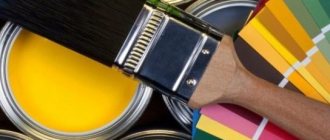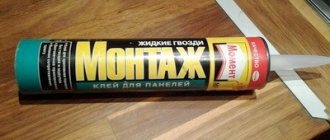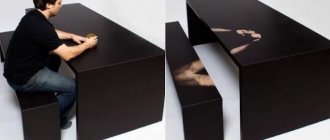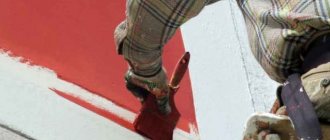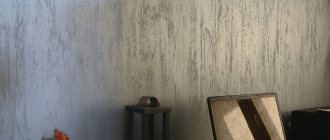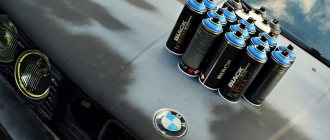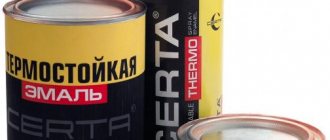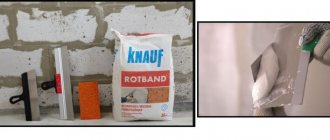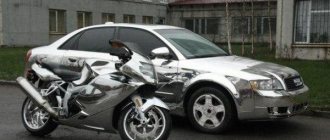Operating principle and scope of application
Glowing paint retains its brightness on the applied surface after the lights are turned off or after dark. Any item in the interior receives this ability if a special composition is applied to it. In stores, such paint is often called luminescent, phosphor or fluorescent.
Luminescent paints accumulate light from external sources throughout the day, and with the onset of darkness they begin to emit it. In this case, the cycle of action can continue for many years. All this is thanks to a pigment called phosphor. It is a physically stable powder with stable chemical functionality.
The lifespan of the phosphor exceeds 30 years. It can be used both for interior work and for facade finishing.
Glowing paint is made by mixing with clear varnish. It is this that influences the range of uses of enamel. It applies to the following:
- decorative finishing of walls and floors in cafes, restaurants and nightclubs;
- phosphorus paint is used for interior items such as sofas, tables and chairs;
- luminescent details in elements of theatrical costumes and makeup;
- in live and artificial flower arrangements;
- on clothing and accessories as logos;
- for painting window frames and gazebos, as well as other wooden structures;
- as tuning of cars and bicycles;
- on special services clothing and road signs.
Recently, luminescent paint has been used for decorative decoration of individual rooms. It is applied to surfaces in the form of a pattern that appears only when the light is off. Professional designers recommend various shades to diversify the interior.
| Price of luminous paint for metal surfaces: 0.5l can 1l can 3l can 5l can 10l can |
Delivery throughout Ukraine starts from 0.5 liters of Ultra luminescent paint for metal surfaces. Prompt delivery to any region around the world is possible.
Glowing paint for metal from Noxton (Ultra)
is a suitable option for painting surfaces that experience dynamic or mechanical stress.
Glowing paint copes well with weather conditions, creating a durable, moisture-resistant and frost-resistant coating in the open air. It is used for painting metal that is in an aggressive environment and in constant motion, thanks to which this type of luminous paint
has become a particularly popular solution in car tuning.
Composition of luminous paint: Self-luminous paint for metal from Noxton is made on the basis of a high-quality acrylic-polymer resin composition with high adhesion, specially prepared for the introduction of a luminous component.
Purpose of luminous paint:
Car wheels (titanium, chrome, stamped), plastic caps, license plates, springs and mechanisms, jeep guards.
Phosphor paint
is used for airbrushing on car bodies and other metal surfaces. The luminous composition copes well with constant contact of water and moisture.
During daylight hours,
self-luminous paint
creates a whitish (translucent) color.
In the dark, the basic colors can glow green and blue (the other colors are listed at the bottom of the page). The duration of the paint glow is (up to 8-12 hours) per 1 cycle; the exact time of luminosity depends on the duration and power of the light source that interacted with the luminous surface. Fluorescent paint
can receive a charge from any light source, the most effective sources are: the sun, ultraviolet, incandescent lamp, fluorescent lamps, DRL lamps, fluorescent lamps, flashlight.
Methods of applying luminous paint:
Brush, roller, swab, spraying.
The surface must be dry and clean. Remove dirt mechanically; Wash off dirt and dust from the surface. Before use, TAT 33 light-accumulating paint must be thoroughly mixed until a homogeneous mass is obtained (mandatory condition). Application in 2-3 layers is recommended. Drying time for each layer is 3-3.5 hours at a temperature of +20°C.
up to 13 m2/l. in 1 layer (depending on the painting method)
The highest brightness of the glow is observed if phosphor paint is applied to a white surface. The darker the surface, the more it absorbs radiated energy. When painting some products, it is recommended to first apply white primer to the surface.
Environmental friendliness of luminous paint:
Not radioactive, not toxic, not flammable.
Store in a tightly closed container at a temperature from -30°C to +40°C. The shelf life of luminescent paint using the “KeepSafe” technology is 200 years *.
0.5l, 1l, 3l, 5l, 10l.
Luminescent paint for metal and metal surfaces is available in the following colors:
Green (base) luminescent paint
- translucent during the day, green glow in the dark
Blue (base) luminescent paint
- translucent during the day, blue glow in the dark
Red luminescent paint
- red during the day, orange-red glow in the dark
luminescent
- yellow during the day, yellow glow in the dark
Orange luminescent paint
- orange during the day, orange glow in the dark
Blue luminescent paint
- blue during the day, blue glow in the dark
Dark Green luminescent paint
- green during the day, green glow in the dark
Pink luminescent paint
- pink during the day, orange-pink glow in the dark
Dark Pink luminescent paint
- dark pink during the day, orange-dark pink glow in the dark
- Self-luminous paint from Noxton is made on the basis of the highest quality luminous material - TAT 33 phosphor
- The distinctive qualities of luminous accumulative paint are its characteristics of brightness and glow duration
- Luminescent paint is sold according to the most optimal price/quality ratios, which is highly valued by our customers
- After application, phosphor paint forms a durable, uniform luminous film, which also acts as protection for the material being painted.
- The shelf life of self-luminous paint using the “KeepSafe” technology is 200 years! This have not happened before
- The Noxton company runs the “It Can’t Be Cheaper” program on an ongoing basis! Find out more about her
- • Glowing paint is made from the highest quality materials with a high degree of purity and will never harm human health and the environment (unlike many others)
- Glowing paint
is the same as: luminescent paint, self-luminous paint, phosphor paint, luminescent paint, luminous varnish, self-luminous varnish, luminous liquid, phosphor paint.
To find out prices for all types of glow-in-the-dark paint from Noxton, go to the “Price List” page.
Return to the catalog of luminous paints from Noxton >>>
* Even if the shelf life of the most transparent base is limited in time, Noxton has developed and implemented a simple and very productive “KeepSafe” technology, thanks to which the luminous component itself can be separated at any time and used with others liquid carriers for 200 years (this is the shelf life of the luminous material TAT 33 from Noxton). This technology will allow you to remove all restrictions on the use of luminous materials. Our customers also find us by queries: luminous paint, glow-in-the-dark paint, how to make luminous paint, luminous paint price, where to buy luminous paints, luminous paint at home, luminous paint for disks, luminous paint in ultraviolet, luminous body paints , luminous paint for disks price, luminous paint luminescent, luminous paint with your own hands, making luminous paint, luminous disks, composition of luminous paint, production of luminous paints, luminescent paint price, where to buy luminescent paint, self-luminous paint, luminous paint, luminescent paint, phosphor paint, luminescent paint, Noxton, new technologies, TAT 33.
Main varieties
There is no officially accepted classification of this paint. But based on the type of active substance, the following types can be distinguished:
- Fluorescent. Its glow appears only in ultraviolet rays. It is often used in exterior decoration, nightclubs and for car tuning. Acrylic varnishes are used for it, which makes the enamel environmentally friendly for human health. Glow-in-the-dark pigments come in a variety of shades. But the most spectacular are green, yellow, pink and red tones.
- Luminescent. This is the most common paint that glows in the dark. She only needs 20 minutes of exposure to daylight or artificial light. Then the resulting surfaces glow in the dark throughout the night. It is usually used as road markings or on barriers at construction sites. Once applied, photoluminescent paint significantly increases safety at industrial facilities.
- Phosphorizing. Due to its phosphorus content, it is hazardous to health. Because of this, it is rarely used and only for painting external elements of buildings and cars. If possible, it is replaced with other types of finishes with luminous elements.
Based on the degree of transparency of the pigment, there are translucent enamels, almost invisible in daylight, and colored enamels, which are visible in the daytime and have a wider color spectrum.
When choosing paint, focus on the coating material. For PVC surfaces, a dye with polyurethane-mineral resins is suitable, as they enhance adhesion. Water-acrylic enamel is often used to paint flower beds. It does not harm plants. And for pools and drains, a waterproof base containing fluorescent ink is suitable.
On video: characteristics and application of luminous paint.
BOSNY Phosphorescent acrylic paint 300ml. (6pcs.)
Description
has unusual functional properties - one of the rational inventions based on the theory of physical sciences, which work effectively in practice where the use of other methods is impossible.
A distinctive feature of luminous phosphorescent paint is provided by the ability of the coating to absorb and accumulate light radiation during the day, with its further transformation into a glow at night. The process of discharging energy tension in the form of light occurs over several hours, when it remains visible in the dark.
Luminous paint is widely used in the road transport industry. Road signs and warning signs, information boards and guides in tunnels, coated with GLOW-IN-DARK phosphorescent paint, serve for traffic safety. Individual vehicles: bicycles, mopeds, motorcycles, equipped with instruments using paint, as well as accessories and protective clothing, make them clearly visible on the night highway. For the safety of the child who goes to school and crosses the road on his own, parents are advised to use paint in the design of a backpack or briefcase.
The reflective properties of the luminous paint will make the figure of a child crossing the road more visible to the driver of the vehicle in the dark.
Phosphorescent luminous paint PHOSPHORESCENT GLOW-IN-DARK is used in advertising. Glowing paint can create a special mood in a theatrical production and will have an unexpected effect if it is used in the design of theatrical scenery and costumes. Representatives of the younger generation enjoy spending time in nightclubs and discos, the stylish design of which involves the use of luminous paint.
The markings, directions and marks left by glowing phosphorescent paint are ideal for this purpose, as is the convenient spray method.
To extend the lifespan and preserve the luminous properties of the phosphorescent paint PHOSPHORESCENT GLOW-IN-DARK, it is recommended to apply a layer of white primer BOSNY -1007 under the paint layer - this will enhance the brightness. Applying acrylic varnish No. 190 over it will secure the luminous effect of the paint . Such integrated use of BOSNY products will make the use of luminous paint optimal.
Features of fluorescent paint
The paint is also called invisible or ultraviolet. Fluorescent ink prevents it from glowing on its own after dark. To produce a light effect, exposure to ultraviolet radiation is required. When artificial light hits it, the surface remains as normal. The composition includes not only fluorescent ink, but also a transparent base.
Paint pigments are represented by powdered dye, which is made of thermoplastic resins. The coloring composition can be applied to surfaces made of glass, metal, wood, plastic and textiles. It can even be applied to flowers that glow in the dark. The composition, which includes fluorescent ink, is non-toxic. It is completely safe for the health of people and animals, and is successfully used in the decoration of residential premises.
It is important to look at the name of the product and what composition it has. Glowing paint must have a product certificate and a safety data sheet. Beware of fakes, as they may be too toxic due to the large amount of phosphorus in the composition.
Phosphors are paints that glow in the dark. A little theory and practice
As promised, continuation of the theme of “colors glowing in the dark.”
About six months ago we were looking for an additional business with elements of entertainment. We settled on phosphors—paints and objects that glow in the dark. Then we supplemented our experience with fluorescent components (glow in ultraviolet light). The real wow effect was when we painted the foam letters with our own hands. I wrote about this in July. Our company currently has a lot of experience working with suppliers and a range of products that we ourselves have tested as high quality.
To begin with, it must be said that there are quite a lot of varieties of phosphors:
- Photoluminescent phosphors
- Electroluminescent phosphors
- Cathodoluminophores
- X-ray phosphors
- Radioluminophores
I'm studying photoluminescent materials. I am giving a link to the only manufacturer of phosphors in Russia that I know of, if anyone is interested in “seeing them all.”
A little theory
The phosphor itself is a powder with a particle size of 15 - 50 microns.
The brightness of the glow depends on the size of the particles. But large particles cannot be used everywhere. For example, if we are talking about application in silk-screen printing or spray painting, then the particle size must fit into the required intervals so as not to clog the mesh or nozzles of the painting equipment. The most common glow colors are yellow-green and turquoise. These are phosphors with a long afterglow (up to 12 hours). It is based on strontium aluminate (SrAl2O4):Eu,Dy,Y. It has excellent resistance to water and various radiations, so its shelf life is practically unlimited. Another advantage is that it is safe for the health of people and animals. I even came across formulations for application to the skin that were hypoallergenic. In addition, the phosphor we are working on is also “charged” in UV rays, which expands the scope of its application.
In daylight, the color of the powder is close to white (slightly greenish). To change color, special fluorescent pigments are used (glow under UV radiation). Added in proportions of 3% -5% by weight of the phosphor. The colors I saw were blue, white, yellow, green, red. The color of the pigments is quite “poisonous”. If you overdo it, you can completely kill the afterglow effect.
By the way, the painted surface will glow truly brightly during the first 60-80 minutes, after which the glow will fade unevenly:
The most common pictures of phosphor application technology look something like this:
In this picture, it is worth explaining only the meaning of the base, reflector, and finishing layer.
- The phosphor does not dissolve and is mixed into the varnish (base) depending on the type of surface to be painted. It is important that the varnish does not contain UV filters, otherwise there will be no afterglow.
- Ideally, the substrate on which the finished composition is applied should be white. It is the white color that serves as the best reflector, resulting in the best afterglow effect.
- After painting with varnish with a phosphor, the surface will be “rough”, because The phosphor particles are still large. Therefore, for gloss and a smooth surface you will need an additional transparent coating.
For those who are eager to learn more about the technology of use and painting, I have posted an archive that I found in the public domain.
Some money
I received several questions in my personal account about creating my own small business using phosphors.
Allow me a couple of paragraphs on this matter.
The situation is ambiguous. I corresponded with about 40 companies that are suppliers or representatives of large wholesalers. Everything is very different depending on the chosen niche and the specific city. One friend, for example, wrote that his sales fell when the white nights arrived.
Everyone vied with each other to write that this is an easy business to start. Nothing like that. Luminophore is an incomprehensible thing for many. Everyone still remembers phosphorus, which has been banned for free use for 15 years and is undoubtedly harmful to health.
You can really make money either from services related to the use of phosphor (interior design, car tuning) or from the sale of large quantities of paint/powder. It is difficult to make money by reselling finished products. It’s good to keep them in the office as examples of applications so that you can “touch” them.
This is due to the fact that on most supplier sites the photos are such that you had to order everything to see what it really looks like.
Some pictures
In general, look for a niche and ask questions. I will answer everyone.
Application Tips
The most convenient option is a spray can, which is sprayed onto almost all surfaces. Phosphorescent paint must be applied in an even layer on a flat and dry surface. It must be mixed thoroughly, because the phosphor may precipitate. Then it is better to apply a second layer. The interval between coating them should be about 1.5 hours.
Electroluminescent paint appears most brightly on a plain surface with light shades. Therefore, in most cases the surface is covered with white primer.
If you plan to use phosphorescent paints, take precautions. Phosphorus is extremely hazardous to health, so such compositions are used outdoors or in a well-ventilated area. Gloves, safety glasses and a respirator must be worn.
Luminous paint is increasingly used in various fields, including interior decoration. When working, use certain proportions and follow a simple process. In this case, nothing will threaten your health, and the surface will be of high quality.
How to make water with a glow effect (2 videos)
Glowing paints for various purposes (35 photos)
New Year is a time of fairy tales, making and fulfilling wishes.
Special luminous paint for woodwork Acmelight™ is an innovative decorative material for construction, repair, landscaping, interior design, design of buildings and structures, landscape design, furniture production, souvenirs, outdoor advertising, etc.
Read more.
High adhesion wood paint is excellent for decorative painting of wood, plywood, fiberboard and chipboard, etc. in order to create a glowing effect in complete darkness. Acmelight Wood glow-in-the-dark paint, having all the properties of conventional paints, has a clear advantage - it glows!
PAINT COLOR PALETTE AND GLOW IN THE DARK:
Color during the day
Color at night
Forms a high-quality color coating. It is allowed to mix paint of different colors to obtain the desired shade (for one type of surface).
PACKING: in tin cans of 0.5 l and 1 l.
WHY ACMELIGHT WOOD PAINT IS THE BEST: A special composition of luminous paint for woodwork developed by the company's technologists, namely: a mixture of organic solvents based on alkyd-urethane resin with the addition of functional additives, ensures the coating glows in the dark for 6 - 8 hours. At the same time, excellent protective waterproofing, increased weather resistance, good acid, oil and gasoline resistance, protection from microorganisms, resistance to frequent exposure to detergents, as well as high wear resistance and strength (resistance to abrasion, tears and scratches) make Acmelight™ luminous paint not simply a unique decorative material, but also an excellent building material. Paint consumption - 1 liter per 6-8 m2 when applied in one layer.
APPLICATION TECHNIQUE: available to both professionals and amateurs /
WHY DOES PAINT GLOW: A surface coated with a layer of luminescent wood paint absorbs light energy from natural or artificial sources and stores it. When darkness falls, the surface begins to glow. The maximum intensity of the glow is observed in the first hour, followed by a gradual decrease. Glow-in-the-dark coating in some cases can become a good alternative to electric lighting, helping to navigate in complete darkness.
WARRANTY CONDITIONS: Store in original sealed packaging at a temperature of +5 to +30 degrees (out of reach of children) for 18 months from the date of manufacture. This period is covered by the manufacturer's warranty.
Glow time: up to 8 hours.
The luminescence effect depends on the color of the paint, the number of layers of paint applied, the thickness of the layer, the light source (through which the paint is charged) and the selected shade of background paint. BUY PAINT!
